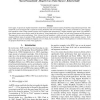Free Online Productivity Tools
i2Speak
i2Symbol
i2OCR
iTex2Img
iWeb2Print
iWeb2Shot
i2Type
iPdf2Split
iPdf2Merge
i2Bopomofo
i2Arabic
i2Style
i2Image
i2PDF
iLatex2Rtf
Sci2ools
LREC
2008
2008
Towards a Vector Space Model for FrameNet-like Resources
In this paper, we present an original framework to model frame semantic resources (namely, FrameNet) using minimal supervision. This framework can be leveraged both to expand an existing FrameNet with new knowledge, and to induce a FrameNet in a new language. Our hypothesis is that a frame semantic resource can be modeled and represented by a suitable semantic space model. The intuition is that semantic spaces are an effective model of the notion of "being characteristic of a frame" for both lexical elements and full sentences. The paper gives two main contributions. First, it shows that our hypothesis is valid and can be successfully implemented. Second, it explores different types of semantic VSMs, outlining which one is more suitable for representing a frame semantic resource. In the paper, VSMs are used for modeling the linguistic core of a frame, the lexical units. Indeed, if the hypothesis is verified for these units, the proposed framework has a much wider application...
| Added | 29 Oct 2010 |
| Updated | 29 Oct 2010 |
| Type | Conference |
| Year | 2008 |
| Where | LREC |
| Authors | Marco Pennacchiotti, Diego De Cao, Paolo Marocco, Roberto Basili |
Comments (0)

